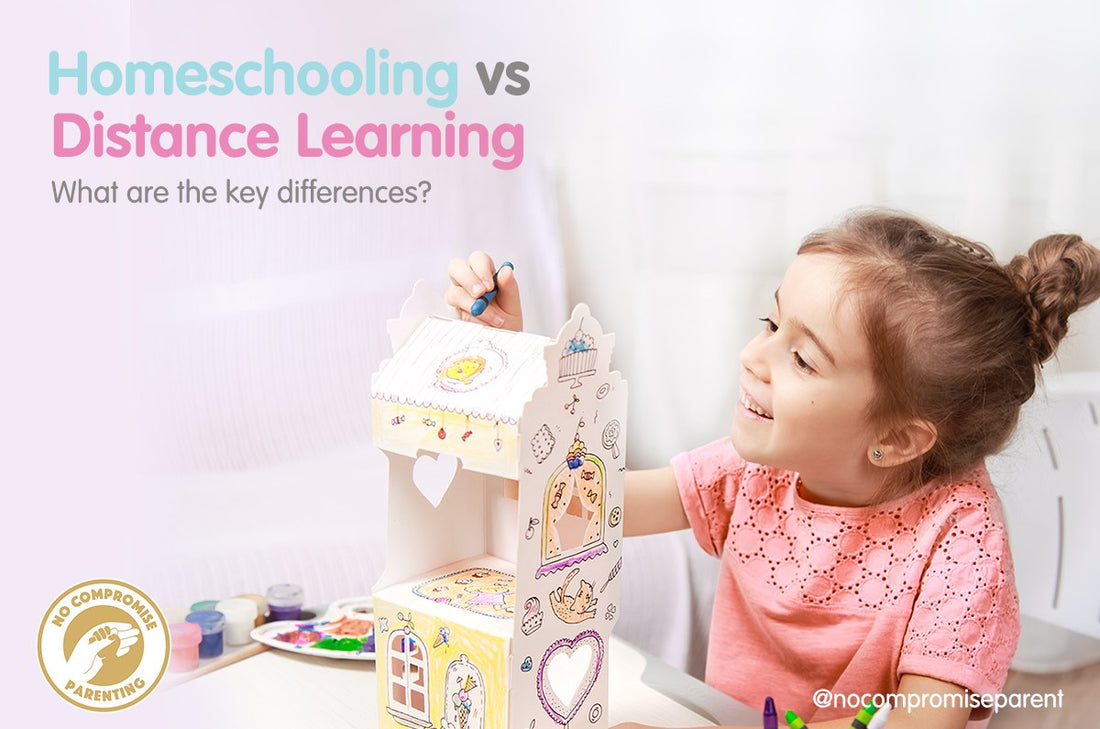No Compromise Parenting
The main difference between home schooling and distance education is that, in home schooling, the curriculum is created by parents while in distance education, the curriculum is designed by an established school or university.
Both home schooling and distance education allow students to acquire knowledge outside of a traditional school structure. Although these two options have many similarities, they are not the same. There is a difference between home schooling and distance education, mainly in terms of the nature of instructors and curriculum followed.

What is Home Schooling
Home schooling or home education is the education of children at home, or in some places other than schools. Home-schooled children do not attend private or public schools. Moreover, the lessons are conducted at home by parents or a tutor. There are many reasons why parents choose the option of home schooling for their children: poor health condition of the child, which prevents him from attending a regular school, parents’ dissatisfaction with the available educational options, and different educational or religious philosophies. Although homeschooling is not legal in some parts of the world, it is an accepted practice in countries like Australia, UK and US.

Pros of Home Schooling
- Flexible schedule
- One-to-one teaching
- Focus on acquiring knowledge, not on getting good grades
- Saves time (no commute)
- Curriculum adjustable according to child’s and parent’s needs
- Safe learning environment
- Allows better bonding between child and parent
Cons of Home Schooling
- May be expensive
- Absence of qualified teachers
- No socialization opportunity for the child
- Not as structured as traditional schools
What is Distance Education
Distance education or distance learning is a way of learning remotely without being in a traditional classroom setting. In other words, the students are not physically present at a school; nor do they come into regular, face-to-face contact with teachers. The history of distance education can be traced back to correspondence courses, where learners corresponded with the school via mail.
At present, distance education usually involves online education; extensive availability of computers and internet facilities have made distance education easier and faster. Video conferencing, webinars, webcasts, instructional television, and message board forums are some technologies used in distance education.

Moreover, distance education programs are available for all ages and educational levels. You can even enroll in advanced distance education courses like Bachelor’s, Masters and PhD degrees.
Types of Distance Education Programs
According to their different formats, there are several main types of distance education programs as follows:
Synchronous distance education – In this type of learning, all the students learn at the same time. This usually involves video or teleconferencing, connecting instructors and learners digitally.
Asynchronous distance education – This format uses learning tasks with deadlines, instead of live online lessons. The students have to self-study to complete the assignments.
Hybrid distance education – This is, in fact, a combination of synchronous and asynchronous elements. For subjects in which students need direct access to the teacher, lessons are more rigidly scheduled, while other lessons can be more flexible. In hybrid learning, students may also have to attend exams physically.
Similarities Between Home Schooling and Distance Education
- Both home schooling and distance education allow students to acquire knowledge outside of a traditional school structure.
- When compared to regular schooling, they have some advantages like flexibility, safety, convenience, and saving time.
- However, in these two methods, students don’t experience the process of socialization like students of regular schools.
Difference Between Home Schooling and Distance Education
Definition
Home schooling is the education of children at home, or in a variety of places other than school while distance education is a way of learning remotely, without being in a traditional classroom setting.
Curriculum
In home schooling, the curriculum is created by parents while in distance education, the curriculum is designed by an established school or university.
Instructors
Parents or guardians of the child usually act as instructors in home schooling while skilled and qualified teachers act as instructors in distance education.
Structure
When compared to home schooling, distance education programs may be more organized and structured as they are created by established educational institutes.
Assessments
Students of distance education programs will have to face assessments and exams, but home-schooled children may not face this requirement.
Subjects
In home schooling, parents can choose the subjects the child must study while, in distance education, selection of subjects depend on the type of program the student is following.
Conclusion
In conclusion, there is a difference between home schooling and distance education, mainly in terms of instructors and curriculum followed. In home schooling, the curriculum is created by parents while in distance education, the curriculum is designed by an established school or university. Moreover, in home schooling, parents or guardians of the child usually act as instructors, but in distance education, skilled and qualified teachers act as instructors. When compared to home schooling, distance education programs may be more organized and structured.
Reference:
https://pediaa.com/difference-between-home-schooling-and-distance-education/
